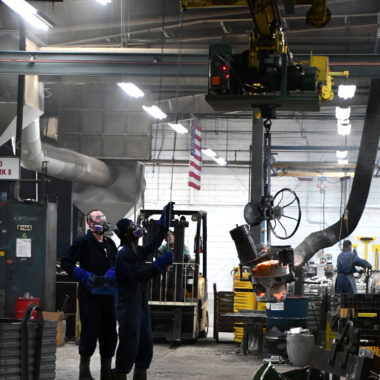Unveiling the Virtuosity: Comprehending About Aluminum Casting
Unveiling the Virtuosity: Comprehending About Aluminum Casting
Blog Article
Crafting Perfection: How to Accomplish High-Quality Aluminum Castings Every Single Time
In the world of light weight aluminum spreading, the pursuit of perfection is a continuous trip that needs a meticulous technique and a keen understanding of the complexities involved. Accomplishing regular high-quality aluminum spreadings demands a comprehensive grasp of the processes, from choosing the appropriate alloy to executing accurate mold designs and meticulously controlling spreading criteria.
Comprehending Light Weight Aluminum Spreading Processes
Light weight aluminum casting processes, necessary in the production sector, involve the intricate change of molten aluminum into solid forms with a series of meticulously controlled steps. Understanding these processes is vital to achieving high-grade light weight aluminum spreadings constantly - about aluminum casting. The primary techniques made use of in light weight aluminum spreading are pass away spreading, sand casting, and investment casting

Each of these processes has its advantages and is chosen based on factors like complexity, volume, and desired coating of the aluminum spreading. about aluminum casting. Comprehending the complexities of these approaches is crucial for manufacturers intending to create high-quality aluminum spreadings continually
Picking the Right Light Weight Aluminum Alloy
Selecting the proper aluminum alloy is a vital choice in the manufacturing of high-grade aluminum castings. The choice of alloy significantly affects the residential properties and characteristics of the last item. Different aluminum alloys use varying degrees of stamina, deterioration resistance, machinability, and thermal conductivity. When choosing an aluminum alloy for spreading, it is vital to take into consideration the particular needs of the application to guarantee optimal efficiency.
One of the most generally utilized light weight aluminum alloys for casting is A356 - about aluminum casting. For applications needing high stamina, 7075 aluminum alloy is a popular choice due to its phenomenal strength-to-weight proportion.
Along with mechanical residential properties, considerations such as cost, accessibility, and post-casting procedures should likewise affect the option of the right aluminum alloy. By very carefully assessing these variables, producers can guarantee the production of top notch light weight aluminum spreadings that satisfy the wanted specifications.
Executing Correct Mold And Mildew Layout
Creating an effective mold style is vital for making certain the successful manufacturing of high-quality light weight aluminum spreadings. Appropriate mold style plays a considerable duty in accomplishing the preferred qualities of the final product. To implement an effective mold and mildew design, variables such as product flow, cooling down prices, and part geometry should be meticulously considered.
One trick facet of mold design is making sure correct dental filling and solidification of the light weight aluminum within the mold cavity. This includes creating runner and gating systems that assist in smooth steel flow and protect against problems such as air entrapment or insufficient dental filling. In addition, integrating cooling networks right into the mold browse around this web-site and mildew design aids regulate solidification rates and decrease the danger of porosity or shrinkage flaws.

Controlling Spreading Parameters

Making Sure Post-Casting Top Quality Checks
To keep the high quality of aluminum castings, extensive post-casting high quality checks are vital. After the spreading process is completed, it is critical to make certain that the final items satisfy the desired requirements and standards.
Dimensional precision is another vital element that must be confirmed throughout post-casting top quality checks. Measurements of crucial measurements and tolerances must be required to verify that the spreadings adhere to the required requirements. Additionally, mechanical buildings such as firmness, tensile toughness, and effect resistance might need to be examined with material testing to make sure that the castings have the required stamina and toughness for their designated application.
Conclusion
In final thought, attaining top dig this quality aluminum spreadings needs a detailed understanding of the spreading processes, choosing the proper alloy, creating mold and mildews effectively, controlling spreading criteria thoroughly, and carrying out post-casting quality checks faithfully. By adhering to these actions, manufacturers can continually generate aluminum spreadings that satisfy the highest requirements of high quality and efficiency.
Achieving consistent premium light weight aluminum castings demands a comprehensive understanding of the processes, from picking the suitable alloy to carrying out exact mold and mildew layouts and meticulously controlling casting criteria. The main methods utilized in light weight aluminum casting are pass away casting, sand casting, and financial investment spreading.
Financial investment spreading, additionally known as precision casting, involves producing wax patterns that are coated in ceramic to create mold and mildews.Choosing the appropriate light weight aluminum alloy is a crucial choice in the production of premium light weight aluminum castings.Making certain accurate control over casting criteria is vital for maintaining uniformity and top quality in light weight aluminum casting production.
Report this page